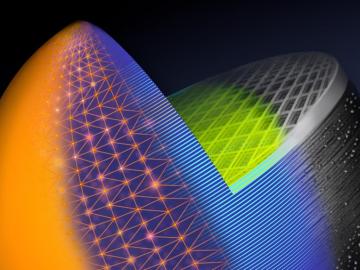
Filter News
Area of Research
- Advanced Manufacturing (14)
- Biology and Environment (5)
- Building Technologies (1)
- Clean Energy (88)
- Fusion and Fission (18)
- Fusion Energy (11)
- Materials (23)
- Materials for Computing (5)
- National Security (2)
- Neutron Science (5)
- Nuclear Science and Technology (9)
- Supercomputing (7)
- Transportation Systems (2)
News Type
News Topics
- (-) 3-D Printing/Advanced Manufacturing (74)
- (-) Fusion (40)
- (-) Transportation (63)
- Advanced Reactors (21)
- Artificial Intelligence (65)
- Big Data (47)
- Bioenergy (67)
- Biology (78)
- Biomedical (42)
- Biotechnology (15)
- Buildings (43)
- Chemical Sciences (38)
- Clean Water (28)
- Climate Change (76)
- Composites (17)
- Computer Science (129)
- Coronavirus (28)
- Critical Materials (17)
- Cybersecurity (17)
- Decarbonization (58)
- Education (2)
- Emergency (2)
- Energy Storage (61)
- Environment (150)
- Exascale Computing (32)
- Fossil Energy (5)
- Frontier (28)
- Grid (47)
- High-Performance Computing (60)
- Hydropower (11)
- Irradiation (2)
- Isotopes (36)
- ITER (5)
- Machine Learning (35)
- Materials (81)
- Materials Science (83)
- Mathematics (9)
- Mercury (10)
- Microelectronics (3)
- Microscopy (31)
- Molten Salt (6)
- Nanotechnology (28)
- National Security (50)
- Net Zero (10)
- Neutron Science (80)
- Nuclear Energy (75)
- Partnerships (22)
- Physics (35)
- Polymers (17)
- Quantum Computing (27)
- Quantum Science (42)
- Renewable Energy (1)
- Security (13)
- Simulation (41)
- Software (1)
- Space Exploration (22)
- Statistics (2)
- Summit (39)
- Sustainable Energy (93)
- Transformational Challenge Reactor (3)
Media Contacts

A new convergent manufacturing platform, developed in only five months at the Department of Energy’s Oak Ridge National Laboratory, is debuting at the International Manufacturing Technology Show, or IMTS, in Chicago, Sept. 9–12, 2024.

ORNL has partnered with Western Michigan University to advance intelligent road infrastructure through the development of new chip-enabled raised pavement markers. These innovative markers transmit lane-keeping information to passing vehicles, enhancing safety and enabling smarter driving in all weather conditions.

Two additive manufacturing researchers from ORNL received prestigious awards from national organizations. Amy Elliott and Nadim Hmeidat, who both work in the Manufacturing Science Division, were recognized recently for their early career accomplishments.

Brittany Rodriguez never imagined she would pursue a science career at a Department of Energy national laboratory. However, after some encouraging words from her mother, input from key mentors at the University of Texas Rio Grande Valley, or UTRGV, and a lot of hard work, Rodriguez landed at DOE’s Manufacturing Demonstration Facility, or MDF, at Oak Ridge National Laboratory.

The Department of Energy’s Oak Ridge National Laboratory has publicly released a new set of additive manufacturing data that industry and researchers can use to evaluate and improve the quality of 3D-printed components. The breadth of the datasets can significantly boost efforts to verify the quality of additively manufactured parts using only information gathered during printing, without requiring expensive and time-consuming post-production analysis.

Oak Ridge National Laboratory has named Troy A. Carter director of the Fusion Energy Division in ORNL’s Fusion and Fission Energy and Science Directorate, or FFESD.

Participants in the SM2ART Research Experience for Undergraduates program got the chance to see what life is like in a research setting. REU participant Brianna Greer studied banana fibers as a reinforcing material in making lightweight parts for cars and bicycles.

Advanced materials research to enable energy-efficient, cost-competitive and environmentally friendly technologies for the United States and Japan is the goal of a memorandum of understanding, or MOU, between the Department of Energy’s Oak Ridge National Laboratory and Japan’s National Institute of Materials Science.

Researchers at ORNL have developed the first additive manufacturing slicing computer application to simultaneously speed and simplify digital conversion of accurate, large-format three-dimensional parts in a factory production setting.

A new study conducted on the Frontier supercomputer gave researchers new clues to improving fusion confinement. This research, in collaboration with General Atomics and UC San Diego, uncovered that the interaction between ions and electrons near the tokamak's edge can unexpectedly increase turbulence, challenging previous assumptions about how to optimize plasma confinement for efficient nuclear fusion.


